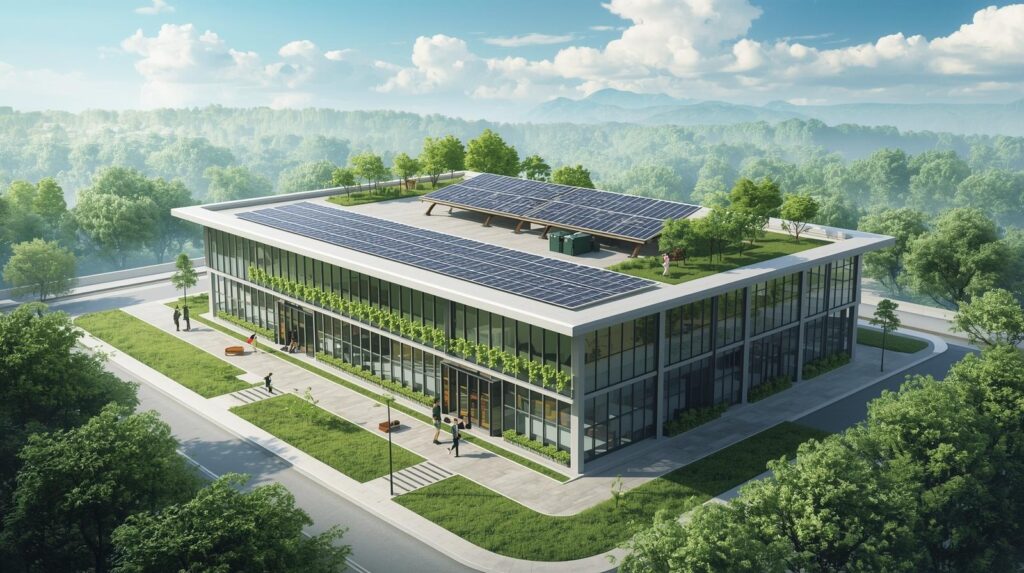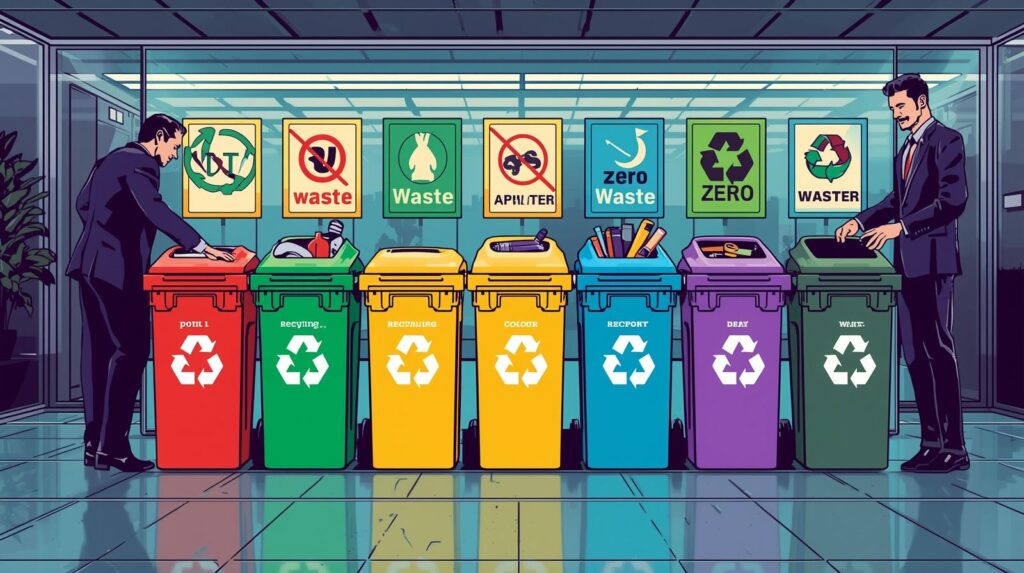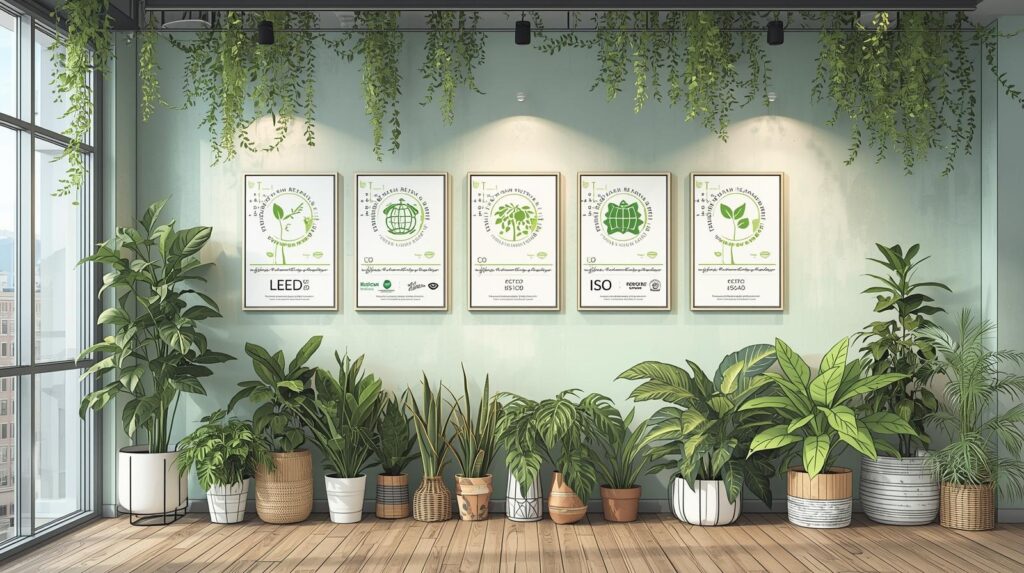(Your Roadmap to Net-Zero, Healthier Workspaces & Competitive Advantage)
Climate policy, corporate reporting standards, and building technologies all changed rapidly between 2023 and 2025. Leading companies now combine rigorous carbon accounting, smart-building tech, and human-centered design to cut operating costs, reduce emissions, and improve employee health and retention. Below you’ll find a practical, plagiarism-free, step-by-step guide to 15 proven practices for creating a Green Office in 2025 — each practice includes why it matters, how to implement it, quick wins, and metrics to track success. I’ll also call out a few important 2025 developments that affect what “green” means for offices today. Friedman Real Estate+4Reuters+4Science Based Targets Initiative+4
Table of Contents
Why update your office sustainability plan in 2025?
- Higher stakeholder expectations. Investors, customers, and employees expect transparent climate plans and measurable reductions. Frameworks like the Science Based Targets initiative (SBTi) and corporate net-zero standards guide credible target setting. Science Based Targets Initiative
- Stricter focus on value-chain emissions. Scope-3 (value-chain) emissions — which include leased offices, employee commuting, and waste — are now front and center. Recent guidance and voluntary codes emphasize measuring and acting on Scope-3. Environmental Protection Agency+1
- Falling costs and rising capabilities of building tech. Smart HVAC controls, predictive maintenance, and building electrification are more affordable and interoperable than before. Famco Manufacturing+1
- Human-centered sustainability. Biophilic and health-forward office design are backed by growing research linking nature, daylight, and air quality to productivity and wellbeing. MDPI+1
1) Set a clear net-zero or near-term emissions target (and align to science)
Why: Targets signal leadership, focus investments, and enable tracking. The SBTi and new corporate net-zero frameworks provide guidance and guardrails so targets aren’t greenwash. Science Based Targets Initiative
How to implement: Choose a near-term (5–10 year) emissions reduction target aligned to 1.5°C pathways where feasible; then plan incremental steps to 2050 net-zero. Use SBTi guidance to shape targets and timelines. KPI: % reduction in absolute (tCO₂e) office emissions year-over-year.
Quick start: Run a high-level baseline for your properties (energy use intensity kWh/m² and tCO₂e).

2) Measure energy use and deploy continuous building monitoring
Why: You can’t manage what you don’t measure. Real-time meters and energy dashboards expose waste, enable fault detection, and show ROI for efficiency projects. Friedman Real Estate
How to implement: Install submeters for HVAC, lighting, plug loads, and water. Use a Building Management System (BMS) or cloud-based energy platform with visualization and alerting. KPI: Energy Use Intensity (kWh/m²), baseline vs after upgrades.
Quick start: Meter a pilot floor or space for 2–3 months and build an energy baseline.

3) Electrify and optimize HVAC with smart controls and heat-pump technology
Why: HVAC is the largest energy consumer in many offices. Electrification combined with smart controls reduces emissions and improves comfort. By 2025, predictive HVAC controls and heat pumps are mainstream. Famco Manufacturing+1
How to implement: Replace aging boilers with electric heat pumps where possible; integrate predictive controls and occupancy scheduling to avoid conditioning empty zones. KPI: HVAC kWh and related tCO₂e per occupied hour.
Quick start: Run an HVAC audit and pilot variable-speed drives + smart thermostats on a single AHU.

4) Move to 100% LED + daylight harvesting and smart lighting
Why: Lighting retrofits are low-hanging fruit: LEDs reduce energy and maintenance; daylight sensors and dimming reduce consumption further. Friedman Real Estate
How to implement: Replace luminaires with high-efficacy LED fixtures, deploy daylight sensors and occupancy sensors, and set centralized scheduling. KPI: Lighting kWh per m², annual lighting savings.
Quick start: Replace lighting in conference rooms and storage areas first; add sensors.

5) Purchase renewable energy (on-site or contracted)
Why: Renewable energy procurement (PPAs, virtual PPAs, or high-quality RECs) helps decarbonize electricity use and signals commitment to stakeholders. KPI: % of electricity from renewables.
How to implement: Evaluate rooftop solar potential, consider community solar or corporate PPA arrangements, and select high-quality renewable certificates if direct procurement isn’t feasible.
Quick start: Get a solar pre-feasibility assessment for roof or carpark.

6) Implement robust Scope-3 accounting and employee engagement
Why: Office emissions often shift into Scope-3 categories (commuting, leased assets, waste, business travel). 2025 guidance increasingly pushes companies to measure and reduce Scope-3, with new voluntary Codes of Practice emerging. Environmental Protection Agency+1
How to implement: Use GHG Protocol tools and EPA/industry guidance to inventory emissions categories relevant to your office footprint. Engage staff with commuting surveys and green commuting benefits. KPI: Scope-3 tCO₂e from commuting, travel, and waste.
Quick start: Run a simple commuting survey and offer a pilot incentive for transit or biking.

7) Retrofit with low-embodied-carbon materials & upgrade building envelope
Why: Operational energy is only part of the story — the embodied carbon in building materials matters too, especially during retrofits or fit-outs. Low-carbon materials reduce lifecycle emissions. Forbes
How to implement: Favor timber, recycled content, and low-embodied carbon concrete alternatives. Improve insulation, glazing, and air sealing to reduce heating/cooling loads. KPI: Embodied carbon (kgCO₂e/m²) for major retrofit elements; reduction in heating/cooling load.
Quick start: Require EPDs (Environmental Product Declarations) from major suppliers for fit-out procurement.

8) Embrace biophilic design to improve health and retention
Why: Research in 2024–2025 strengthened evidence that plants, natural light, material cues, and views to nature reduce stress and improve cognitive function — a win for people and retention. Biophilic offices can also support wellbeing goals while signaling sustainability commitments. MDPI+1
How to implement: Add living walls, increase indoor plant density, prioritize views, and use natural materials and daylighting strategies in office layouts. KPI: Employee wellbeing survey scores, absenteeism rates, and retention over time.
Quick start: Add greenery to shared spaces, upgrade plants maintenance, and map daylight availability.

9) Reduce waste via circular procurement and take-back programs
Why: Office waste (electronics, furniture, packaging) contributes to Scope-3 emissions and landfill. Circular purchasing and vendor take-back reduce embodied emissions and cost.
How to implement: Specify remanufactured toner, modular furniture with take-back clauses, and IT lease/refresh programs that include refurbishment. KPI: Waste diverted from landfill (%), tons of e-waste recycled.
Quick start: Negotiate a take-back clause in next furniture or IT purchase.

10) Right-size real estate: consolidate, repurpose, or retrofit stranded offices
Why: Shifting work patterns mean some buildings are underused. Repositioning underused space with sustainable retrofits or repurposing reduces emissions per employee and avoids maintaining inefficient assets. Recent real-estate reporting encourages sustainability-driven repositioning. Forbes
How to implement: Use occupancy analytics, evaluate subleasing, and consider conversion to mixed-use or greener functions. KPI: Occupancy rate vs emissions per employee.
Quick start: Run a 90-day occupancy sensor pilot to understand true utilization.

11) Introduce sustainable commuting options and travel policies
Why: Commuting and business travel are often material Scope-3 sources. Encouraging low-carbon options and smarter travel policy reduces emissions and supports employee wellbeing. Environmental Protection Agency
How to implement: Offer transit subsidies, EV charging, bike-to-work facilities, and set a travel policy with emissions thresholds and virtual meeting defaults. KPI: % employees using low-emission commute modes; travel tCO₂e per FTE.
Quick start: Install a small number of EV chargers and run a commuter-mode challenge.

12) Use green procurement: furniture, IT lifecycle, and certified cleaners
Why: Procurement choices cascade through supply chains (Scope-3). Choosing certified, low-impact products lowers embodied emissions and improves indoor environmental quality.
How to implement: Create preferred vendor lists requiring environmental certifications (e.g., EPEAT for IT, FSC for timber, low-VOC for paints). Include lifecycle disposal or take-back clauses. KPI: % procurement spend on certified/green products.
Quick start: Add sustainability criteria to the next RFP for IT or facilities services.

13) Adopt digital tools for space optimization and hybrid work
Why: Flexible work reduces the need for large footprints. Space-management tools can shrink real estate emissions and improve utilization, but must be paired with policy to avoid rebound effects.
How to implement: Use desk-booking, analytics, and meeting room sensors to right-size space and plan for flexible arrangements. KPI: m² per active employee; emissions per active employee.
Quick start: Pilot a hot-desk booking tool for one wing or building.

14) Tie sustainability to procurement, KPIs, and executive compensation (carefully)
Why: Putting measurable sustainability metrics in procurement contracts and executive incentives helps ensure follow-through. However, metrics must be transparent and credible to avoid accusations of greenwashing. SBTi and other frameworks can help. Science Based Targets Initiative
How to implement: Tie part of procurement scoring to lifecycle emissions; include credible sustainability KPIs in executive scorecards only after ensuring data integrity. KPI: % of contracts with sustainability clauses; progress against verified targets.
Quick start: Add a sustainability weighting to supplier evaluations.

15) Communicate transparently and credibly — disclose methods and progress
Why: Stakeholders expect honesty and method disclosure. Don’t just publish high-level claims—show baselines, assumptions, and third-party verification where possible. Recent guidance and voluntary codes emphasize transparency for Scope-3 and carbon credit use. Reuters+1
How to implement: Use GHG Protocol accounting, publish inventory boundaries, and disclose reductions and use of offsets only with clear limits and quality criteria. Consider third-party assurance for material claims. KPI: Public disclosures completed; third-party assurance obtained.

Quick implementation roadmap (first 12 months)
- Month 0–2: Executive alignment, baseline energy & Scope-3 screening, pick pilot floors/buildings.
- Month 3–6: Install submeters, pilot smart controls and sensors, LED retrofit in targeted areas.
- Month 6–9: Roll out commuting incentives, biophilic quick wins (plants, daylight seating), green procurement clauses.
- Month 9–12: Evaluate pilot outcomes, set near-term emissions target, plan major HVAC/electrification projects, begin renewable procurement conversations.
Sample KPIs to track (dashboard essentials)
- Energy Use Intensity (kWh/m²/year) — by building and by function
- Total tCO₂e (Scope 1, 2, and prioritized Scope 3 categories) — annual and per FTE
- % Electricity from renewables
- Waste diversion rate (%) and e-waste recycled (tons)
- Occupancy and space utilization (m² per active employee)
- Employee wellbeing score and retention change post-biophilic upgrades
2025 policy & market signals to watch (recent developments)
- Scope-3 Action Code of Practice (2025): New voluntary frameworks and codes of practice in 2025 emphasize credible Scope-3 measurements and require companies to set near-term reduction plans and be transparent about use of carbon credits. This raises the bar for office reporting and supplier engagement. Reuters
- SBTi & Corporate Net-Zero Standards (ongoing 2024–25): SBTi continues to be the leading framework for science-aligned target setting; aligning office portfolios to those standards strengthens credibility. Science Based Targets Initiative
- Government guidance on Scope-3 & accounting tools: Agencies such as the US EPA and international bodies offer updated guidance and training on Scope-3 inventories — practical tools for offices to measure their value-chain emissions. Environmental Protection Agency+1
Cost vs benefit — typical payback examples
- LED + sensors: Often <2-year payback in many climates.
- Smart HVAC controls: Payback 2–5 years depending on existing controls and energy prices.
- Rooftop solar (where feasible): Long-term stable energy price hedge; simple payback depends on incentives and roof condition.
- Biophilic investments: Harder to monetize directly but show measurable benefits in retention and productivity indices (lower recruitment costs and fewer sick days).
Common barriers & how to overcome them
- Data gaps: Start small with submeters and data pilots, then scale.
- Upfront capital: Use ESCOs, performance contracts, or green leasing to shift CAPEX.
- Behavioral rebound: Pair tech with policy and engagement; celebrate and reward low-carbon choices.
- Supplier inertia: Add sustainability into RFPs and create multi-year contracts with improvement milestones.
Sample “Green Office” checklist (quick)
- Baseline energy + quick submeters installed
- LED retrofit + sensors in high-use areas
- HVAC audit completed & pilot smart thermostats operational
- Commuting survey + incentives for low-carbon modes
- Green procurement criteria added to RFP templates
- Biophilic upgrades in common areas completed
- Scope-3 screening completed and priority categories identified
- Public commitment (near-term target) published with methodology
Final notes: credibility matters more than perfection
In 2025 the narrative shifted: optimism about tech remains, but markets and civil society demand credible action, measurable reductions, and transparent method disclosure. Use recognized standards (GHG Protocol, SBTi), be honest about what you can measure now, and plan continuous improvement. Recent policy and voluntary codes reinforce that Scope-3 and high-quality reporting will increasingly determine reputational and financial outcomes for office operators and corporate occupiers. Environmental Protection Agency+1
(Your Roadmap to Net-Zero, Healthier Workspaces & Competitive Advantage)
Introduction
By 2025, the bar for sustainable offices has risen dramatically. Stakeholders, investors, regulators, and employees now demand not just cursory “green offsets,” but rigorous emissions reductions, transparent methodologies, and human-centric design. Many corporate offices that once boasted “LEED Gold” are now falling behind peers who leverage smart tech, net-zero roadmaps, and deep Scope-3 engagement. In this post, we unpack 15 proven practices to build a Green Office in 2025 — blending bold vision, measurable action, and trend-savvy tactics.
We’ll cover (1) why updating your office sustainability plan matters today, (2) the 15 practices themselves (with how-to steps, “quick wins,” and KPI ideas), (3) a structured rollout plan, and (4) a strategy for persuasive, SEO-friendly storytelling to your stakeholders.
Why a Fresh Green Office Strategy Matters in 2025
- Stakeholder expectations have evolved
In 2025, investors and regulators expect credible climate plans anchored in recognized frameworks. Superficial claims now trigger scrutiny or even backlash. - Scope-3 is no longer optional
Offices often shift emissions into commuting, leases, and supply chains. New voluntary codes and climate frameworks emphasize Scope-3 transparency and action.
Example: In May 2025, a new Code of Practice aimed at narrowing the “Scope-3 emissions gap” was released. - Smart building tech is mature and cost-effective
Building analytics, fault detection systems, heat pumps, electrification, and IoT integration have dropped in cost and improved interoperability. - Health, retention, productivity advantages
Biophilic principles, daylighting, clean air, and nature integration now show measurable effects on wellness, concentration, and staff retention. Offices that neglect occupant experience risk losing talent. - Energy markets and policies favor clean power
Renewable procurement, carbon pricing, incentives, and energy efficiency grants are expanding globally. Offices that optimize now can lock in cost savings and carbon avoidance.
Given these forces, old “green office” checklists are inadequate. Let’s move to actionable practices you can deploy or scale in 2025.
1. Define a Credible Net-Zero or Near-Term Emissions Target
- Why it matters: A public, science-aligned target demonstrates leadership, guides investments, and maintains credibility.
- Action steps:
- Choose a baseline year and gather energy, fuel, and emissions data.
- Use tools from GHG Protocol and SBTi to model reduction pathways.
- Commit to a near-term (5–10 year) target aligned to 1.5°C, then plan toward 2050 net-zero.
- Quick win: Run a high-level emissions baseline for your office portfolio (e.g., kWh/m², tCO₂e).
- KPI example: % year-on-year reduction in absolute tCO₂e from office operations.
2. Install Real-Time Submetering & Energy Monitoring
- Why it matters: You can’t fix what you don’t measure. Real-time data unlocks actionable insight, fault detection, and optimization.
- Action steps:
- Submeter HVAC, lighting, plug loads, and water.
- Deploy a centralized Building Management System (BMS) or cloud analytics platform.
- Configure dashboards, alerts, and benchmarking.
- Quick win: Start with submeters on a single pilot floor or zone for 90 days.
- KPI example: Energy Use Intensity (EUI, kWh/m²·year) before and after upgrades.
3. Electrify HVAC + Integrate Smart Controls & Heat Pumps
- Why it matters: HVAC is typically the largest energy consumer in offices. Electrification plus control yields big carbon and cost savings.
- Action steps:
- Audit existing HVAC systems for replacement potential.
- Evaluate heat pumps or electric VRF systems in place of fossil heating.
- Add smart thermostats, predictive controls, occupancy scheduling, and variable speed drives.
- Quick win: Pilot a smart thermostat upgrade or control overlay on one AHU.
- KPI example: HVAC energy (kWh) and tCO₂e per occupied day/zone.
4. Convert to 100% LED + Smart Lighting & Daylight Harvesting
- Why it matters: LED retrofits are a classic “low-hanging fruit,” but coupling with smart controls and daylight sensors pushes savings further.
- Action steps:
- Replace legacy fluorescents or older lighting with high-efficiency LED fixtures.
- Deploy occupancy sensors, dimming, and daylight harvesting in suitable zones.
- Centralize scheduling via BMS or lighting control systems.
- Quick win: Retrofit conference rooms, storerooms, and less trafficked zones first.
- KPI example: Lighting energy consumption (kWh), annual % savings.
5. Procure Renewable Energy (On-Site, PPAs, or High-Quality RECs)
- Why it matters: Even with efficiency, net emissions can only plummet significantly if electricity is renewable.
- Action steps:
- Assess solar potential on rooftops, facades, or canopies.
- Explore corporate PPAs or virtual PPAs.
- Supplement with high-integrity RECs (with avoidance of double counting).
- Quick win: Commission a solar feasibility or shading study.
- KPI example: % of total electricity from renewable sources (on-site + off-site).
6. Tackle Scope-3: Inventory, Engage, and Act
- Why it matters: Many office emissions actually sit in commuting, travel, supply chain, waste, and leased assets. New 2025 guidance requires measurable Scope-3 disclosures.
- Action steps:
- Use GHG Protocol Scope-3 tools and external guidance to screen major categories.
- Conduct commuter surveys, travel logs, waste audits, and supply chain questionnaires.
- Engage employees (e.g., incentives, awareness) and key suppliers (e.g., green clauses).
- Quick win: Run a pilot commuting survey and offer a transit/bike incentive.
- KPI example: tCO₂e from prioritized Scope-3 categories (commuting, travel, waste) per FTE.
7. Retrofit Using Low-Embodied-Carbon Materials + Thermal Upgrades
- Why it matters: One-time retrofit and construction emissions (embodied carbon) can dwarf operational savings if materials are poorly chosen.
- Action steps:
- Specify materials with Environmental Product Declarations (EPDs).
- Favor low-carbon options (e.g., cross-laminated timber, recycled-content steel, low-carbon concrete, reclaimed materials).
- Improve envelope: insulation, glazing, air sealing, thermal breaks.
- Quick win: Require EPDs or carbon labels in next fit-out RFP.
- KPI example: Embodied carbon (kgCO₂e/m²) for major retrofit phases; reduction in heating/cooling demand post-upgrade.
8. Embrace Biophilic & Wellness-Driven Design
- Why it matters: Green offices are not just about energy — occupant health and experience matter. Biophilic design yields tangible benefits like reduced stress, higher productivity, and stronger retention.
- Action steps:
- Increase indoor plant density, living walls, and planters.
- Maximize daylight, views, natural materials, and visual connection to nature.
- Integrate multi-sensory elements (water, nature sounds, texture).
- Quick win: Add green zones or planter clusters in lobbies and break rooms.
- KPI example: Employee wellbeing survey scores, absenteeism rate shifts, retention improvements.
9. Implement Circular Procurement & Take-Back Programs
- Why it matters: Waste, especially e-waste and furniture, contributes to embodied emissions and landfill impact. A circular approach recaptures value and reduces cradle-to-grave burdens.
- Action steps:
- Use remanufactured or refurbished IT and components.
- Include take-back or buy-back clauses with vendors.
- Prefer modular, repairable furniture and office systems.
- Quick win: Negotiate a take-back or refurbishment promise in your next IT contract.
- KPI example: % of office waste diverted; tons of e-waste recycled or refurbished.
10. Right-Size Real Estate & Reposition Underused Assets
- Why it matters: Post-pandemic hybrid work models mean many offices are underutilized. Consolidating, retrofitting, or repurposing “stranded” properties can trim emissions and costs.
- Action steps:
- Deploy occupancy sensors and analytics to determine real usage.
- Consolidate or sublease underused space.
- Retrofit older buildings for new functions (mixed-use, labs, studios) or upgrade to green standards.
- Quick win: Pilot occupancy sensors in key zones for 90 days.
- KPI example: m² per active employee; emissions per FTE.
11. Promote Low-Carbon Commuting and Smarter Travel Policies
- Why it matters: Employee commutes and business travel often dominate office Scope-3 footprints. Encouraging cleaner commuting and tighter travel policy reduces emissions and supports wellbeing.
- Action steps:
- Offer transit subsidies, bike storage, showers, EV charging, carpool incentives.
- Adopt a “virtual meeting default” policy and restrict policies for flights under certain distances.
- Track and offset residual travel emissions only with high-quality offsets.
- Quick win: Install a few EV chargers and run an internal mobility challenge.
- KPI example: % of employees using low-carbon commuting modes; tCO₂e from business travel per FTE.
12. Use Green Procurement for IT, Furniture & Services
- Why it matters: Procurement decisions ripple through supply chains (Scope-3). Choosing certified, low-impact products and services aligns emissions goals and indoor quality objectives.
- Action steps:
- Define criteria and weighting in RFPs for sustainability (e.g., EPEAT, ENERGY STAR, FSC).
- Mandate take-back, repairability, and product longevity.
- Use certified cleaning products (e.g., low-VOC, green chemistry).
- Quick win: Update your next IT or facilities RFP to include sustainability scoring.
- KPI example: % of spend on certified green items or services.
13. Adopt Space-Optimization Tools & Hybrid Work Models
- Why it matters: Rental energy, HVAC, and lighting per employee can shrink if space is used more efficiently. But space tools must be used with policies to prevent rebound (i.e., over-expansion).
- Action steps:
- Deploy desk-booking software, meeting room sensors, and utilization analytics.
- Use insights to shrink footprint or repurpose zones.
- Make hybrid-work rules clear, and avoid “just in case” space hoarding.
- Quick win: Pilot desk-booking in one building or floor.
- KPI example: Active employee-to-area ratio (m² per user); emissions per active user.
14. Align Sustainability with Procurement & Executive Compensation
- Why it matters: Without “skin in the game,” initiatives may stall. But binding metrics must be transparent, credible, and appropriately weighted.
- Action steps:
- Add sustainability scoring to procurement RFPs and supplier selection models.
- Embed measurable climate KPIs (energy, carbon, waste, or Scope-3) into executive scorecards, once data systems are reliable.
- Use phased adoption to avoid forcing dashboards with poor data.
- Quick win: Add a small sustainability weight in the next major supplier RFP.
- KPI example: % of supplier contracts with sustainability clauses; progress on verified target metrics.
15. Communicate Transparently & Publish Progress
- Why it matters: Stakeholders demand credible disclosure, not marketing fluff. Transparent methodology, assumptions, and independent assurance are now essential.
- Action steps:
- Use GHG Protocol methods, declare boundaries, report reductions, and note assumptions.
- Publish annual climate or office-sustainability reports.
- Seek third-party assurance of material claims or carbon accounting.
- Quick win: Publish an introductory baseline report with methodology appendix.
- KPI example: Whether disclosure was published; whether assurance was obtained.
12-Month Implementation Roadmap
| Period | Core Activities | Milestones / Outputs |
|---|---|---|
| Months 0–2 | Executive alignment, baseline energy & emissions, pilot site selection | Energy and emissions baseline; pilot floor(s) identified |
| Months 3–6 | Submetering, energy dashboards, LED retrofits in pilot zones | Dashboard live, initial lighting upgrades, analytics beginning |
| Months 6–9 | HVAC pilot (smart controls), commuting survey, green procurement clauses | HVAC pilot commissioned; first procurement RFP updated; commuter data collected |
| Months 9–12 | Evaluate pilot results, scale successful measures, commit to target, begin renewable procurement talks | Full report on pilot; public near-term target announced; vendor offers evaluated |
Once the first year establishes data, credibility, and stakeholder buy-in, subsequent years can scale electrification, renewables, circular procurement, building retrofits, and expansion.
Sustainable Office Design, Eco-Friendly Workplace, Green Business Strategies, Future of Green Offices, Office Sustainability Tips.




